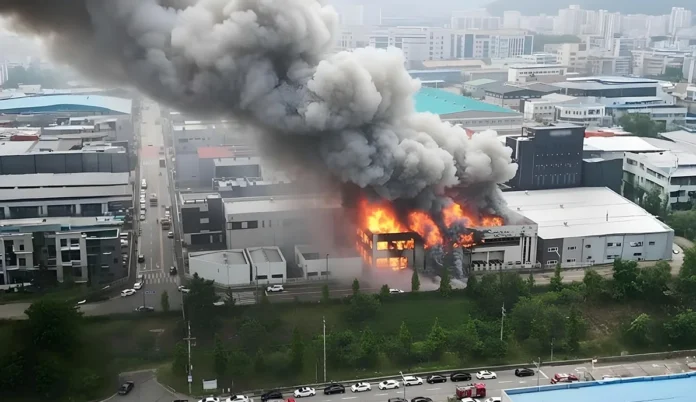Data Center Inferno Exposes Hidden Dangers of Faulty Energy Storage Technology
DAEJEON, South Korea — A powerful explosion ripped through a central data center in South Korea’s Daejeon region on Friday, killing and injuring workers and disrupting digital services nationwide. Officials have confirmed that the source of the blast was a faulty lithium-ion battery system, reigniting concerns about the growing threat posed by this unstable technology.
The fire, which started deep inside the energy storage section of the SK Group’s operating facility, spread rapidly through the building’s server rooms. Witnesses described hearing a “thunderous boom” followed by clouds of black smoke billowing into the sky.
“It was like a bomb went off,” said one worker who narrowly escaped. “The flames spread in seconds, and everyone was running for their lives.”
Firefighters battled the blaze for hours, struggling against toxic fumes and the risk of further explosions as hundreds of lithium-ion battery cells overheated and burst one after another. Authorities were forced to evacuate surrounding buildings and shut down nearby roads as a precaution.
The South Korean government has invested heavily in renewable energy and battery-powered infrastructure, but this incident has exposed the dark side of lithium-ion technology. These batteries, widely used in inverter systems, electric vehicles, and large-scale energy storage units, are now being called a “silent hazard” by safety experts.
When lithium-ion cells fail, they undergo a process known as thermal runaway, a chain reaction of heat, gas, and fire that can’t be easily stopped. Unlike traditional fires, lithium battery fires burn hotter, release toxic gases, and often reignite hours or even days after the initial incident.
“This is not an isolated case. We’ve seen similar lithium-ion explosions in California, Germany, and Japan,” said energy safety analyst Park Min-soo. “The world is rushing into this technology without fully understanding how dangerous it can be.”
The Daejeon explosion is the latest in a string of lithium battery fires worldwide. From power plants to residential buildings, the pattern remains the same: overheating, explosion, destruction.
In January, a lithium-based storage unit in California’s Moss Landing power facility caught fire, forcing evacuations. In April, a battery system in Germany caused an apartment complex to catch fire. Now, the same story has unfolded in South Korea, only on a far larger scale.
Experts warn that these incidents highlight a systemic flaw in the production and deployment of lithium-ion batteries. Cheaply made, poorly regulated, and often overloaded, they pose a growing risk to lives and property.
South Korean safety regulators are now investigating the Daejeon disaster, but consumer groups say this tragedy should serve as a wake-up call for the entire world.
“These so-called ‘clean energy’ batteries are becoming ticking time bombs,” said consumer rights advocate Han Soo-jin. “Governments must enforce stricter quality control, mandatory safety certifications, and transparent labeling, before more people die.”
As nations push toward electrification and renewable storage, the pressure to adopt lithium-ion systems has outpaced safety oversight. Millions of such batteries are now installed in homes, vehicles, and industrial sites, each carrying the potential for catastrophic failure.
A Warning Ignored
The Daejeon fire is more than a local accident; it’s a warning. Lithium-ion batteries, hailed as the backbone of the green energy revolution, are proving to be dangerously unstable when mishandled or manufactured carelessly.
Until stricter global standards are enforced, every battery could be a potential disaster waiting to happen.
The question is no longer whether these batteries can fail; it’s when they will.
Read the Latest Battery News Shaping the Global Power Market.
Massive Fire in Korea Caused by Lithium Battery Blast- Source


